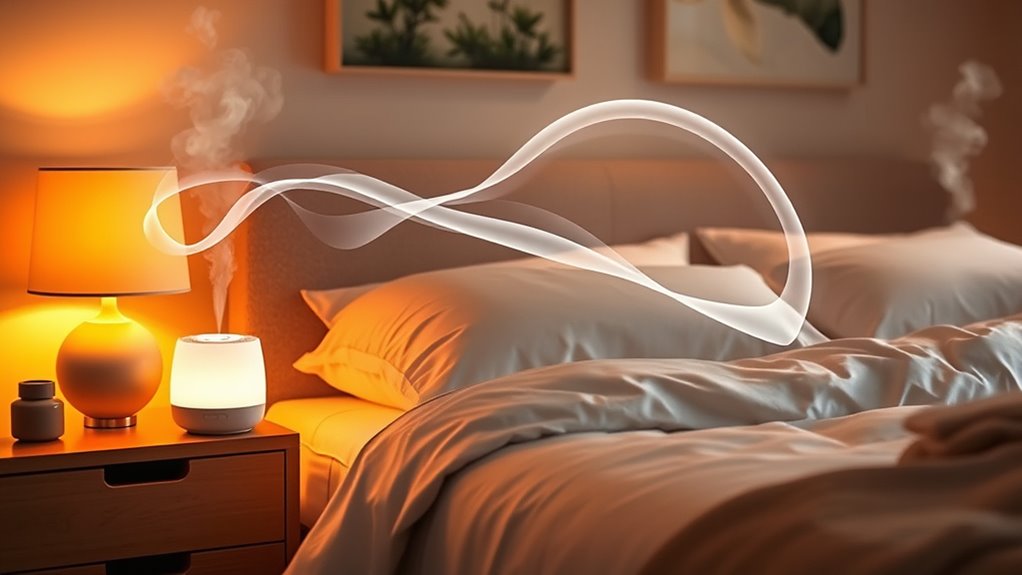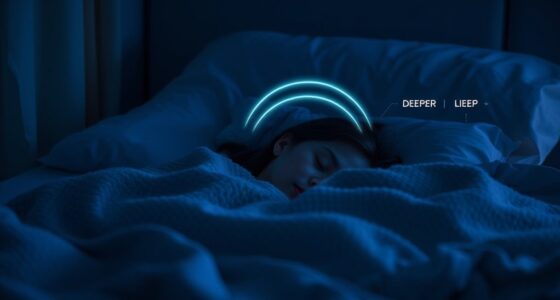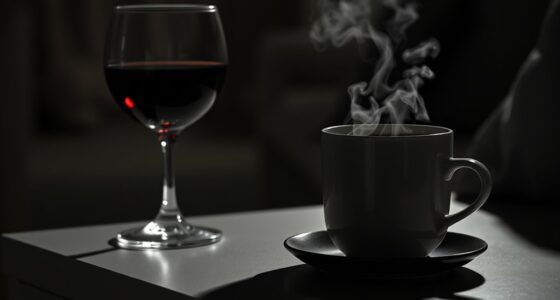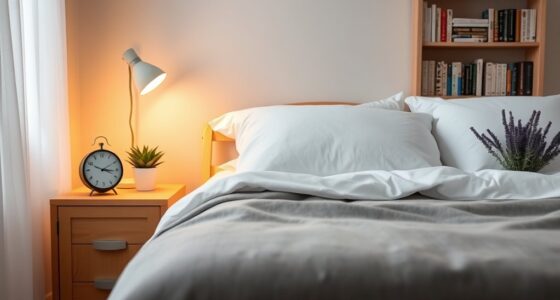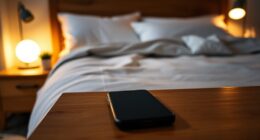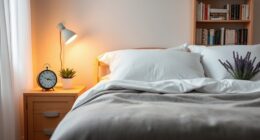To enhance your sleep quality with white noise and soundscapes, select calming sounds that match your preferences, like rain or soft music, and use a quality device or app to play them at a comfortable volume near your bed. Set a timer so the sounds stop after you fall asleep, and maintain a consistent routine to signal bedtime. Keep experimenting with different sounds until you find what relaxes you most—there’s more to discover for better sleep.
Key Takeaways
- Choose calming sounds like gentle rain or ocean waves that suit your preferences for relaxation.
- Position your sound source near the bed at a comfortable volume to mask external noises without causing discomfort.
- Use devices with adjustable volume and timers to create a consistent, soothing sleep environment and prevent sound from disrupting sleep.
- Incorporate sound therapy into your nightly routine to signal bedtime and improve sleep association over time.
- Experiment with different soundscapes to find the most effective option for enhancing your sleep quality.
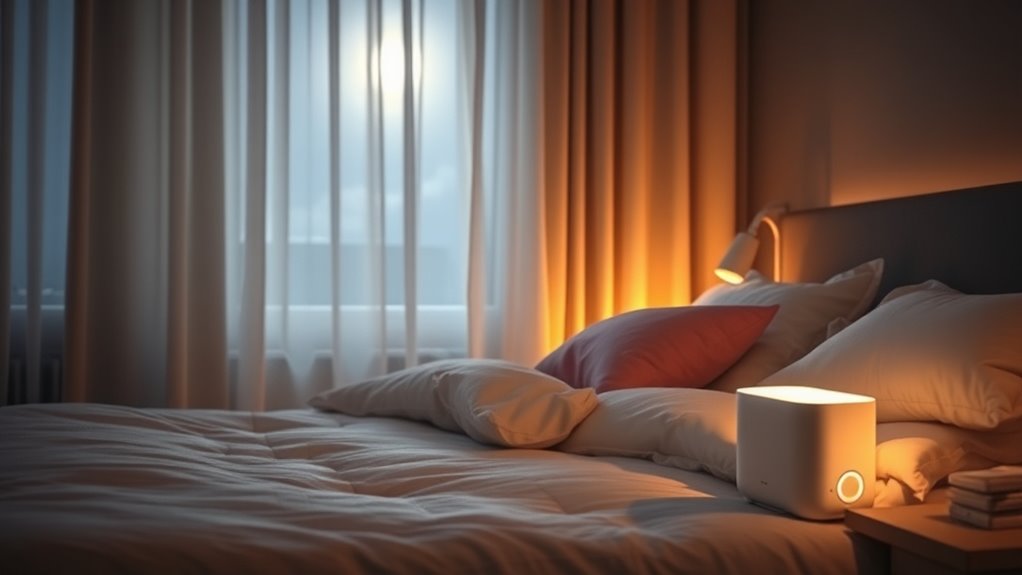
White noise and soundscapes are effective tools for improving focus, relaxation, and sleep. When used correctly, they can transform your sleep environment, helping you fall asleep faster and enjoy more restful nights. One way to harness their power is through sound therapy, which involves listening to carefully curated sounds designed to promote relaxation and healing. Ambient recordings, a popular form of sound therapy, include gentle nature sounds, soft instrumental music, or steady white noise that create a calming atmosphere. These recordings help drown out disruptive background noises, making it easier for you to *shift* into sleep and stay asleep throughout the night.
To use sound therapy effectively, start by choosing high-quality ambient recordings that suit your preferences. Some people find the sound of rain or ocean waves particularly soothing, while others prefer the steady hum of white noise or nature sounds. Many apps and streaming platforms offer a wide selection of ambient recordings designed specifically for sleep. Experiment with different sounds to discover what resonates with you and provides the greatest sense of calm. Once you identify your preferred sounds, set a timer or use a sleep feature on your device to turn off the audio after several hours, preventing disruption in the middle of your sleep cycle.
Position the source of your ambient recordings or white noise generator near your bed but not directly under your pillow. This proximity ensures the sound envelops you without being overly loud or intrusive. If you’re using a device, try to keep the volume at a comfortable level—loud enough to mask external noises but not so loud that it causes discomfort or makes it harder to fall asleep. Keep in mind that consistency is key; incorporating sound therapy into your nightly routine can *guarantee* your brain to associate these sounds with sleep, making it easier to relax each night.
You can also explore specialized sound machines that produce continuous ambient recordings. Many of these devices feature adjustable volume, timer functions, and a variety of sound options, making it simple to customize your sleep environment. Using these tools regularly can help improve your sleep quality over time, especially if external noise disturbances are common in your environment. Remember, the goal is to create a peaceful, predictable soundscape that signals to your brain it’s time to unwind and rest. With a little experimentation and routine, sound therapy and ambient recordings can become invaluable allies in your pursuit of better sleep.
Frequently Asked Questions
Can White Noise Cause Hearing Damage Over Time?
White noise can cause hearing damage over time if the volume is too loud or if you’re exposed to it for extended periods. For hearing safety, keep noise levels below 70 decibels and avoid prolonged exposure. Noise exposure at high volumes can damage your hearing, so use white noise devices carefully. Always monitor the volume and limit listening time to protect your ears and maintain healthy hearing.
Are There Any Health Risks Associated With Continuous Soundscape Use?
Long-term exposure to continuous soundscapes can pose health risks, especially if you’re noise sensitive. Studies show that prolonged loud noise may increase stress levels and impact your hearing health. To stay safe, keep volume levels moderate and take regular breaks. If you’re concerned about noise sensitivity, choose softer or nature-based soundscapes and monitor how your body responds. By doing so, you can enjoy sleep benefits without risking your health.
How Loud Should White Noise Be for Optimal Sleep?
You should set your white noise at a volume that’s loud enough for noise consistency but not overwhelming, typically around 50-60 decibels. Use volume calibration to find this balance, ensuring it masks disruptive sounds without causing discomfort or hearing damage. Keep the sound steady throughout the night to promote relaxation and uninterrupted sleep, adjusting as needed to maintain a comfortable, consistent environment.
Can Soundscapes Be Effective for Children or Infants?
Soundscapes can be effective for children and infants by promoting their comfort and supporting healthy sleep patterns. You should choose gentle, calming sounds like lullabies or nature noises that suit their preferences. Keep the volume low to avoid overstimulation. Using soundscapes consistently helps create a familiar sleep environment, making it easier for your child to fall asleep and stay asleep longer.
Is White Noise Suitable for People With Tinnitus?
In the age of dial-up internet, white noise can be a helpful tool if you have tinnitus. It often supports tinnitus management by masking ringing sounds, making it easier to relax and fall asleep. Use sound therapy with white noise at a comfortable volume, avoiding sudden changes. Always consult with a healthcare professional to tailor the approach, ensuring it’s safe and effective for your specific needs.
Conclusion
Using white noise and soundscapes can considerably improve your sleep quality by masking disruptive sounds and creating a calming environment. Studies show that 80% of people experience better sleep when using these sounds regularly. So, give it a try—whether it’s a gentle rain or soft white noise—and see how your sleep transforms. Better rest isn’t just a dream; it’s within your reach. Start today, and wake up feeling refreshed and ready to face your day.
